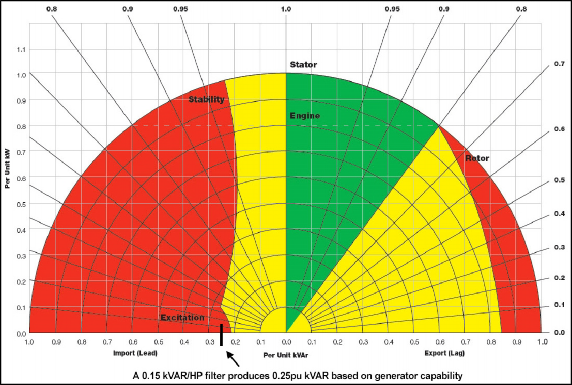All passive filters on the market today regardless of kVAR require capacitor disconnect contactors to be compatible with small generators at no load.
Passive Filter Operation Review
Passive filter operation review: Passive filters are an effective solution to filter harmonic currents produced by 6-pulse VFDs and reduce the source current THD to 5% or less. Passive filters are typically constructed with a series line reactor (Lr) and a shunt circuit made of a tuning reactor (Lt) and capacitor (C), as shown in Figure 1.
The tuning circuit supplies the harmonic current needed by the VFD and the capacitor supplies leading current (or leading VARs) at the fundamental frequency of the power system. When the VFD is lightly loaded these leading VARS flow in the voltage source – typically a utility transformer or generator. As the VFD’s load increases it draws more lagging VARs, which consume the capacitor VARs and reduce the leading VARs that flow in the source.

Generator Reverse kVAR Limit
Synchronous generators have limited capability to provide either leading or lagging VARS as is reflected in a typical generator capability chart is shown in Figure 2 [1]. The green shaded area is the normal operating range of a typical generator, the yellow is abnormal but not damaging and operating in the red region will cause damage. The reverse or leading kVAR level at the boundary of the stability region is approximately 0.2 pu of rated KVAR.
For example, a generator rated at 100kVA and a 0.8 PF is rated for 80 kW and 60kVAR. A leading kVAR of 0.2pu equates to 12kVAR, which would exceed the capabilities of the generator. Thus, a generator rated for 0.8 PF, can support only about 0.12 of its rated kVA at no load. This level is detailed in application examples from generator suppliers [2], [3].
Some generator manufacturers suggest a more conservative guideline that a generator has the capability to support 10% (0.1 pu) of its kVAR capability with leading kVAR [1].
Compatibility at No Load
To examine the compatibility of passive filters without contactors and small generators at no load consider the following example:

- Generator: 100kVA, 0.8PF. Rated for 80kW and 60kVAR
- Passive filter: 100HP with 15 kVAR capacitance (0.15kVAR /HP)
The leading kVAR produced by the filter at no load is 15kVAR. Since the generator is rated for 60kVAR, the generator needs to produce 0.25pu leading kVAR (15kVAR / 60kVAR). This exceeds the maximum 0.2 pu capability and the recommended 0.1 pu level. The load curve of the 100HP filter mapped onto a 100kVA generator capability graph is shown in Figure 2.
To achieve generator compatibility for this example, a contactor must be used to keep the capacitors offline during light VFD loading conditions.
Conclusion
All passive filters on the market today exceed generator reverse kVAR limits at no load. To achieve generator compatibility at no load without a contactor, the kVAR/HP levels have to be below 0.12kVAR/HP as an absolute limit. Using the recommended thumb rule in the sizing publication [1], the level has to be below 0.06 kVAR/HP.
References
- “How to size a genset: Proper generator set sizing requires analysis of parameters and loads”, Cummins Power Topic #7007. https://www.cumminspower.com/www/literature/technicalpapers/PT-7007-SizingGensets-en.pdf
- “Synchronous Generators and Leading Power Factor Loads”, ePower News, Fall 2011, Issue 2, Toromont CAT Power Systems. http://www.toromontcat.com/powersystems/pdf/newsletter/Synchronous%20Generators%20and%20Leading%20Power%20Factors.pdf
- “Impact of leading power factor loads on synchronous alternators”, Cummins Power Topic #6001. http://power.cummins.com/sites/default/files/literature/technicalpapers/PT-6001-ImpactofPowerFactorLoads-en.pdf
